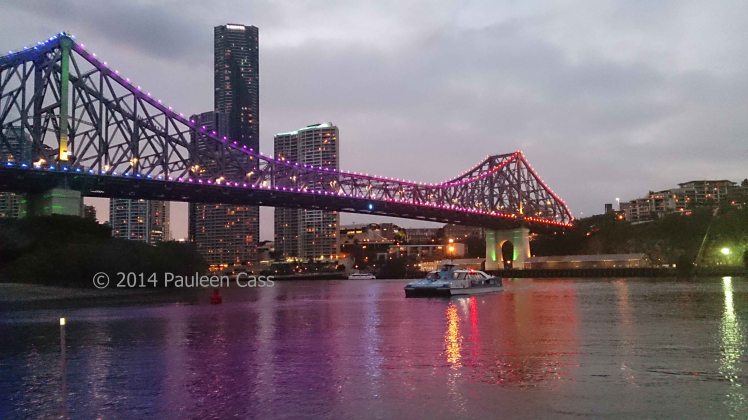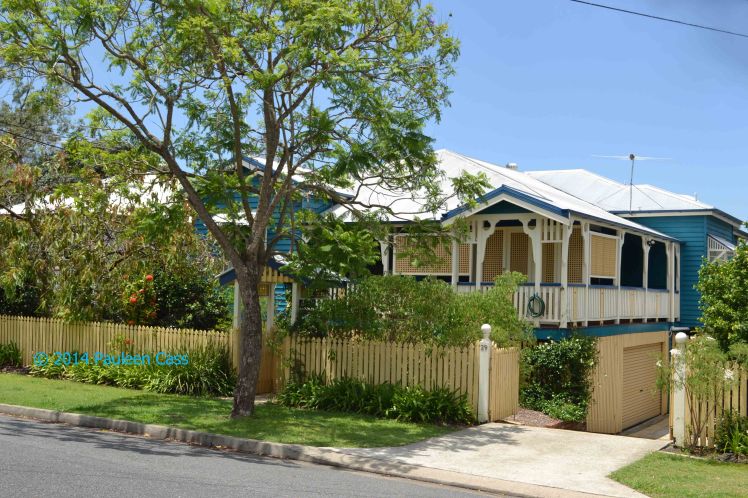 I’ve just begun an e-book of short stories, A First Place, by David Malouf. Absorbing stories written by Australians always seem slightly disorienting, so accustomed are we (or is it only me?) to reading books whose settings are elsewhere. Which came first, the sense that “other is better”, leading to the exodus of much of Australia’s talent, or the relative weighting of other and local?
I’ve just begun an e-book of short stories, A First Place, by David Malouf. Absorbing stories written by Australians always seem slightly disorienting, so accustomed are we (or is it only me?) to reading books whose settings are elsewhere. Which came first, the sense that “other is better”, leading to the exodus of much of Australia’s talent, or the relative weighting of other and local?
One story, A First Place, is about growing up in Brisbane and how its particular topography and lifestyle defines not only who we become as adults, but how we think. That certainly gave me pause for thought, and I can’t decide the merits of the case, but is that because it’s part of me?
Brisbane is a hilly city – not mountainous, just hilly, where travelling by car or foot anywhere involves the negotiation of hills. From a large-scale view, the hills are not so obvious, it’s when one is on the ground that it becomes so much more apparent. One of the earliest things a Brisbane learner-driver has to come to terms with is hill starts in a geared car. After nearly two decades of living in flat-as-a-tack Darwin I sometimes forget I have to change gears or use more power when going up a hill. Our geography does change our daily patterns.

Malouf posits that the topography of the city means “it shapes in those who grow up there a different sensibility, a cast of mind, creates a different sort of Australian”. The hilliness of the city means that its residents miss the long vistas of flatter cities like Adelaide or Melbourne. They become accustomed to new views at every rise, and this may make them restless in the absence of variety, as well as precluding a clear map of the mind. I’d suggest it might also inculcate a sense of mystery in the same way that a door into a garden, rather than shut you out, makes you more curious what lies behind…or is that, once again, the Brisbane girl in me? He’s certainly correct that it gives the legs a good workout, especially if you grew up relying on Shanks’ pony to get you everywhere – something that’s noticeably absent from Darwin’s flatness, and the laziness that tropical humidity generates.
He also talks about the river’s unusual snake-like twisting through the city: one of the reasons the flooding a few years back caused so much damage, as it has in the past. Add to that the relative lack of bridges forcing the traveller to negotiate twice as many suburbs as a direct route would allow. The river conspires to shut off vistas as do the hills, but I think it also opens up a sense of a city of two sides on both banks.

Now that the river has become an active character in the Brisbane landscape with the arrival of the City Cats (ferries) along with the riverside walkways, it does open up the city in a different way. In much the same way as the hills, it makes you wonder (if you don’t already), what is round the next corner. No wonder a river tour has become so popular over the past decades.
The hills and river combine in a story my father has handed down. I often wondered whether it was something he’d made up, even though it made eminent sense, until a friend whose father was also a born-and-bred old Queenslander confirmed the same story. In the pioneering days, the drays would travel across the city along the ridges of the hills when the river was in flood. My father did much the same when my cousin’s house was in imminent risk of flooding back in 1974, helping him to get his belongings up to the ceiling before the flood hit (reaching very close to the ceiling – two floors).

As Malouf says, Brisbane has a radial design, striking out from the city centre. In the days when few families had their own car, this meant that setting out on a journey could make two suburbs seem immeasurably far apart, and mystifyingly disconnected. This is how I experienced visits to my grandfather at Buranda from Kelvin Grove, or family friends at the outside reaches of Mt Gravatt. It wasn’t until we acquired a car, or until I travelled more by car, that the geography of the city started to make sense in a quite different way. The CBD of the city may be suitably laid out in grid-fashion (and flat) but not the rest of the place. Motorways (and bus lanes) cut through suburbs like knives now, but the new tunnels and underpasses generate a lack of knowledge of the landscape above, until one pops out, bandicoot-like, at the other end, hopefully in the right place, or somewhere you recognise and can navigate from.

Malouf also has a theory that Brisbane’s tree-house-like homes, built on stilts to accommodate the hills and introduce breezes, affect the psyche of those who grew up there. His argument is that their openness, with doors always ajar, introduce an element of not-seeing, not-hearing as appropriate to the circumstances. The timber of the building moves in a way that brick structures do not, and are more vulnerable to climate as well as protecting the family from it. I’m not entirely sure that I agree with his thesis on the effect of Brisbane (or more accurately, tropical, housing). It seems predicated on a particular type of house, the old Queenslander with its encircling verandahs rather even than post-war timber housing, and certainly not on the more modern brick bungalow or two-story house. On the other hand, doors are only shut here because of air-conditioning so perhaps he has a point.
“Under the house” is a different world from that above where all serious living takes place. Home of the household washing machine, tubs, wringer or boiler, Dad’s workbenches and the kids’ play area, it has a sort of wondrousness about it as well as a daily practicality. It offers the chance to explore what Malouf calls “a kind of archaeological site”, hosting as it does all sorts of odds and ends that have found their way to rest there, as well as on-going practical items. This space certainly features prominently in my childhood memories of both my own home and that of my grandparents next door. I used to love using my grandfather’s vice to crack the Queensland nuts (now known as macadamias) which grew on our tree. Usually enclosed by timber battens, “under the house” is both open and yet secure. Surely this experience is different from those for whom a basement may serve similar functions?
Malouf asks himself “what habits of mind such a city may encourage in its citizens, and how, though taken for granted in this place, they may differ from the habits of places where geography declares itself at every point as helpful, reliable, being itself a map”. I suspect it gives your internal GPS such good training that ever after you are more able to understand other places.

If a good writer’s goal is to make one think, and challenge our internal assumptions, then Malouf has achieved this for me today.
Have you thought about the impact of the geography of where you grew up? Do you think it has affected how you see the world psychologically and emotionally, your habits and sense of the world’s geography.
Book: A First Place, David Malouf. Random House 2014. A collection of personal essays and writing from David Malouf to celebrate his 80th birthday. This includes the following short story: A First Place. 1984 Blakelock Lecture.

Interesting. I grew up on the southside where it isn’t that hilly. Definitely nothing like the Kelvin Grove, Red Hill areas where you can have entry at street level and 20 foot stumps at the back of the house. I definitely found major differences when I went from southside to northside visiting but many, many more differences going to Melbourne in 1978.
LikeLike
A good point Helen, that it depends where you lived. We later lived at Sunnybank Hills so still had the hills to contend with. Melbourne and Brisbane are very very different in all sorts of ways aren’t they?
LikeLike
Thanks Pauleen. You have given me much to think about. Living in Brisbane was certainly different to Canberra and Melbourne but is it the topography or simply the climate? The latter also tends to impact on what kind of houses we build and what transport we use and how we spend our leisure time. I liked Nick Earl’s Zig Zag Street for growing up in Brisbane. Have you read that?
LikeLike
Thanks for dropping by Shauna. I agree the climate is critical which is why, in part, I don’t find Darwin as different as others from more southerly states but his idea about topography resonated with me as well. No, I’ve heard of Zig Zag Street but haven’t read it…must put it on the list.
LikeLike
A very informative & thought provoking post. I do think back to the house & area in Surrey that I grew up in, in the 1970s & wonder at the differences that both my Mum & Grandmother would have seen growing up (remarkably) in the same road although at different houses (and different times); It was probably this that started my One-Place study on that road. Your post has though made me think at a deeper level at the road, it’s location, part of the bigger picture of the area & how it came to be the rat run it is today.
Here in England we do not have the many differences & contrasts across our small country that Australia has. Even comparing England to Wales there are less differences, although I can think of a couple. The differences would be perhaps England/Scotland & even Northern Ireland. Whilst they are all technically different Countries, there are subtle differences, but many more similarities. Compared with Australia – different time zones & vast differences across the different States, yet all one very large Country.
LikeLike
I will be thinking about the geography of the different places I’ve lived today. We lived in a house on stilts in Mississippi and the space under the house is very different from a closed in basement. I did miss a basement during tornado season though.
LikeLike
How interesting, but logical, that Mississippi has houses on stilts too. I did smile at missing the basement in tornado season…I would too;-)
LikeLike
It wasn’t at all logical 😛 The people who built the house chose that model for I know not what reason. Houses without basements (most) were built close to the ground, a few feet up at most. There was no water to flood anywhere near. If we’d stayed there we would have closed it in for a ground floor.
LikeLike
Hmm, interesting and slightly odd…perhaps there’d been a stray Queenslander through there 😉
LikeLike